June 15, 2018
Air Date: June 15, 2018
FULL SHOW
SEGMENTS
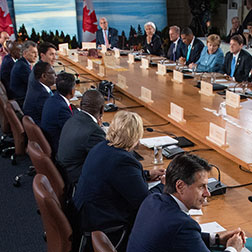
Tough Climate At The G7
View the page for this story
The Group of Seven – including leaders from Canada, France, Germany, Italy, Japan, the United Kingdom and the United States – recently met for the 44th G7 Summit in Quebec, Canada, with climate as one of the items on the agenda. President Trump walked out before the climate discussion. The Summit ended in a conspicuous rift between the United States and its closest allies, with implications for international climate policy. Host Steve Curwood speaks with Alden Meyer, the Director of Strategy and Policy at the Union of Concerned Scientists. (05:20)
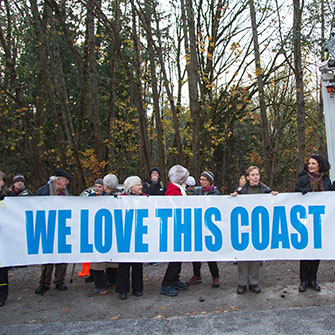
Canada Buys Tar Sands Oil Pipeline
View the page for this story
Canadian Prime Minister Justin Trudeau recently announced that the federal government will fund Kinder Morgan’s Trans Mountain Pipeline, which would carry oil sands crude and refined oil for export from Alberta to the coast of British Columbia. The deal has angered many climate activists, but the Canadian government says it’s important to the economy. Host Steve Curwood spoke with National Observer Managing Editor Mike De Souza, based in Ottawa, Canada. (07:40)
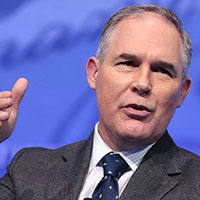
EPA Dilutes Toxics Law
View the page for this story
The Toxic Substances Control Act of 1976 was strengthened by a Congressional overhaul in 2016 that provided uniform federal review standards for thousands of everyday chemicals, and gave the EPA power to review them for safety. But just two years later, the EPA is narrowing the mandate. Britt Erikson of Chemical and Engineering News tells Host Steve Curwood that EPA is investigating ten chemicals of special concern out of the tens of thousands that need review with criteria focused on direct exposure that ignore air and water quality issues and overlook legacy uses of substances like asbestos. (07:07)
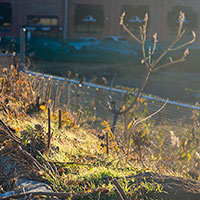
Beyond the Headlines
/ Peter DykstraView the page for this story
Looking this week’s Beyond the Headlines, Peter Dykstra and Host Steve Curwood discuss the new life that’s being given to a notorious Superfund site in Toms River, NJ, as an open-air classroom for local high school students; and they consider the ongoing hostilities over water between Texas and New Mexico. The weekly history lesson features a flash back to June 17th, 1942, when FDR directed the US Army to build the first atomic bomb, a project later known as the Manhattan Project. (03:57)

BirdNote: Exquisite Thrush Song
/ Michael SteinView the page for this story
Thrushes are widely regarded to have some of the most musical bird songs. BirdNote’s Michael Stein explains how these birds use a special anatomical structure to create their elaborate songs. (02:01)

Atlas of a Lost World: Travels in Ice Age America
View the page for this story
The Americas have been home to humans for at least fifteen thousand years, and people appear to have left signs they were here far earlier, too. Some apparently journeyed used boats to travel along the coast of what is now Russia and Alaska as well as possibly trekking the Bering land bridge. In his book, Atlas of a Lost World: Travels in Ice Age America, author-adventurer Craig Childs follows in their footsteps. Speaking with Host Steve Curwood, Childs tells the story of a search for understanding about the people who journeyed here long ago and reflects on how a changing climate could have spurred them to adapt. (15:01)
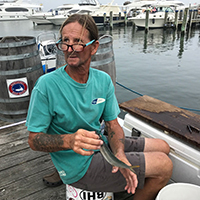
Audio Postcard: A Fisherman Rigging Bait on Nantucket
/ Matt HoischView the page for this story
Nantucket Island has a long history of providing safe harbor to seafarers and whalers, and today, luxury cruising and fishing boats dock there. Among the polished yachts, the Living on Earth team found a scrappy fisherman with a weather-beaten face nimbly prepping bait. Living on Earth contributor Matt Hoisch produced this audio postcard. (02:44)
Show Credits and Funders
Show Transcript
HOST: Steve Curwood
GUESTS: Craig Childs, Britt Erickson, Alden Meyer, Mike De Souza
REPORTERS: Peter Dykstra, Matt Hoisch, Michael Stein
[THEME]
CURWOOD: From Public Radio International – this is Living on Earth.
[THEME]
CURWOOD: I'm Steve Curwood.
The G7 has cut major deals on climate negotiations in the past, but this year President Trump walked out early before climate was even on the table.
MEYER: It was a key moment for the other six countries to realize that Mr. Trump is not a solid negotiating partner and that they would have to go it alone, not just on the climate issue but on a whole range of challenges.
CURWOOD: Also, Canadian Prime Minister Justin Trudeau is on the hot seat for buying a failing pipeline that would increase exports of climate-disrupting oil sands crude.
DE SOUZA: You have people who had knocked on doors and spent hours volunteering their time to campaign for the liberals in the last election that are very angry. People who say, you know, I spent all this time campaigning for you and I feel betrayed.
CURWOOD: That and more this week on Living on Earth – Stick Around!
[NEWSBREAK MUSIC: Boards Of Canada “Zoetrope” from “In A Beautiful Place Out In The Country” (Warp Records 2000)]
[THEME]
Tough Climate At The G7
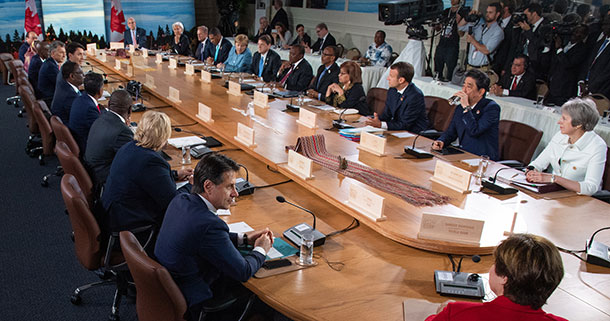
The 44th G7 Summit gathered leaders from Canada, France, Germany, Italy, Japan, the United Kingdom, and the United States. Together, they discussed topics such as the global economy, gender equity and climate change. (Photo: G7Charlevoix, Flickr)
CURWOOD: From the Jennifer and Ted Stanley Studios at the University of Massachusetts, Boston, this is Living on Earth. I’m Steve Curwood.
A key agenda item at the Group of Seven leadership summit has been international climate negotiations, but when these heads of government recently met in Quebec, President Trump left the meeting early. Mr. Trump skipped the discussions on climate change, refused to sign the G-7 communique, and insulted Canadian Prime Minister Justin Trudeau, calling him weak and dishonest. Climate negotiation expert Alden Meyer is the Director of Strategy and Policy at the Union of Concerned Scientists.
Welcome back to Living on Earth!
MEYER: Thanks, Steve. Good to be with you.
CURWOOD: So, tell me how important was this G7 Summit to the goals of the Paris climate agreement?
MEYER: Well, it was a key moment for the other six countries to realize that Mr. Trump is not a solid negotiating partner, and that they would have to unite and move ahead without him. I don't think this was a surprise to many of them. They've experienced him over the last year and a half since he took office. But I think his behavior at the summit really imprinted on them personally that they're going to have to go it alone, not just on the climate issue, but on a whole range of challenges. Of course, the issue that really precipitated the breakdown at the G7 Summit was trade, and President Trump’s unilateral imposition of tariffs on many of our key allies.
German Chancellor Angela Merkel called the decision by President Donald Trump and the US delegation to abstain from the G7 summit's statement "sobering and somewhat depressing" https://t.co/Ct23jL6vn1 pic.twitter.com/bUsmavpLqc
— CNN International (@cnni) June 11, 2018
CURWOOD: So, given that Mr. Trump didn't participate, what needed to be decided by the others at this meeting?
MEYER: They need to decide what signal they want to send particularly to developing countries about how serious they are at meeting their Paris commitments; at ramping up financial assistance for developing country action; and laying out long-term, more ambitious goals for emissions reductions in their own economies; and they did that. They did that by bifurcating the section in the communique on climate change, oceans and energy with a very short common paragraph that applied to all seven countries, and then much more detail on what the other six countries were willing to commit to.
CURWOOD: Talk to me about how that meeting ended and the mood as things wrapped up.
MEYER: Well, I mean the mood was already a little bit helter-skelter because of the president arriving late, leaving early; of course, having some very rough discussions from what we understand in the private room on trade; and then of course, it really went south when the president tweeted that he was instructing the United States representatives to withdraw from the joint communique that he had hours earlier agreed to in the room with the other six leaders. And we understand that was triggered by a fit of pique at watching Prime Minister Trudeau’s press conference after the summit wrapped up where Prime Minister Trudeau just reiterated what he had said in the meeting to the president, which is that he would be forced to react to the U.S. unilateral tariffs on steel and aluminum with tariffs of their own on American products, and apparently that pushed the president over the edge.

US President Donald Trump (left), Canadian Prime Minister Justin Trudeau (center) and Sophie Trudeau (right), prior to Trump’s early departure from the summit and his firing off a barrage of less-than-friendly tweets at Mr. Trudeau. (Photo: Official White House Photo by Shealah Craighead)
He instructed the US to withdraw and, of course, the next day we saw some of his representatives using some very overheated rhetoric on the talk shows, saying there was “a special place in hell” for people like Justin Trudeau.
CURWOOD: So, President Trump comes late, leaves the talks early. Looking ahead, Alden, what sort of implications could that behavior have on future international talks, including those on climate?
MEYER: Well, I think it just underscores what people were already intuiting, which is that President Trump is not a reliable negotiating partner. Of course, we saw that on Paris; we saw that on the Iran deal; and now we're seeing it on trade and on the G7 communique. It also, I think, ups the incentive for the Europeans in particular to figure out how they find other negotiating partners on a range of issues. The obvious one they're all trying to figure out is China, where their interests can align with China versus where they still have some differences or competition on issues like trade.
CURWOOD: How furious are the other G6 at the United States climate and the whole package? There is this now viral picture of Chancellor Angela Merkel from Germany leaning over the table staring at Trump, and Trump has his arms crossed looking very much like a petulant child who's been kind of caught doing something wrong.
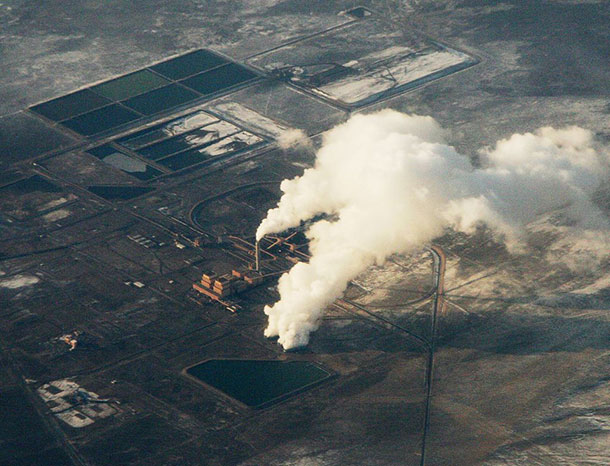
The United States stood out as the outsider during the G7 by continuing to support the fossil fuel industry while the other six countries stood firm in their commitment to the Paris Climate Agreement. (Photo: Doc Searls, Wikimedia Commons)
MEYER: Well, I think there is a fair amount of anger from the other leaders that were at the summit, you know, because what I understand from reports from people that were in the room, is that the negotiations were tough, but they did find accommodation with the US; they worked out agreement on the communique; they accepted some of President Trump's and the US team's request for some rewrites and edits; and that they thought they had a deal. And so to make those kind of concessions and to try to come to consensus only to have the president withdraw the US by tweet, I think really took a lot of people off guard. It wasn't something they'd ever experienced before. It's clearly not the way you do diplomacy, the long-term implications that I think remain to be seen.
CURWOOD: Alden Meyer is Director of Strategy and Policy at the Union of Concerned Scientists. Thanks so much for taking the time today, Alden.
MEYER: I was glad to join you, Steve.
Related links:
- InsideClimate News: "Six of the G7 Commit to Climate Action. Trump Wouldn't Even Join Conversation."
- Union of Concerned Scientists Press Release
- NYTimes: "Trump Refuses to Sign G7 Statement and Calls Trudeau 'Weak'"
Canada Buys Tar Sands Oil Pipeline
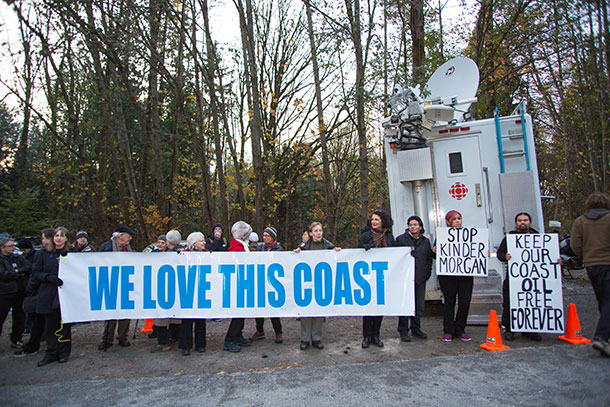
Thousands of protestors have gathered from time to time at the Trans Mountain pipeline terminal on Burnaby Mountain to protest Kinder Morgan’s pipeline expansion. (Photo: Mark Klotz, Flickr CC BY 2.0)
CURWOOD: G7 host and Canadian Prime Minister Justin Trudeau has had a tough couple of weeks, insulted by President Trump over trade and criticized at home over a tar sands pipeline.
The private sector doesn’t want to finance an expansion of the Kinder Morgan Trans Mountain Pipeline, so over the protests of climate activists, Mr. Trudeau says his government will buy it, with a tab north of four and a half billion Canadian dollars. The pipeline to the west coast would boost Canada’s trade with Asia as it carries oil sands crude, a potent climate disruptor.
Mike De Souza is the National Observer’s Managing Editor based in Ottawa. Welcome back to the program, Mike.
DE SOUZA: Thanks for having me.
CURWOOD: So, the last time we spoke, Justin Trudeau had just been elected. That was 2015. So, what kind of climate promises did he make at the dawn of his term in office?
DE SOUZA: Well, you know, I think everyone remembers that he said Canada is back. You know, one of his first public appearances after becoming the prime minister, he went to Paris and he pushed the Canadian delegation to push the rest of the world to strive to meet a target of keeping global warming below 1.5 degrees Celsius above pre-industrial levels.
CURWOOD: Yeah, I remember seeing Trudeau in Paris at the big climate summit. He attracted a lot of attention. He was meeting with the most important leaders from around the world. It seemed like it was going to be a new day in Canada for dealing with the climate after Stephen Harper, the previous prime minister who had pretty much towed the line that the fossil fuel companies wanted.
DE SOUZA: There was a period over the past 10 years in which the government was not wanting to talk about climate change where scientists were discouraged from speaking to reporters. There was a lot of them that were saying that they felt muzzled, and that they couldn't even talk about the issue.
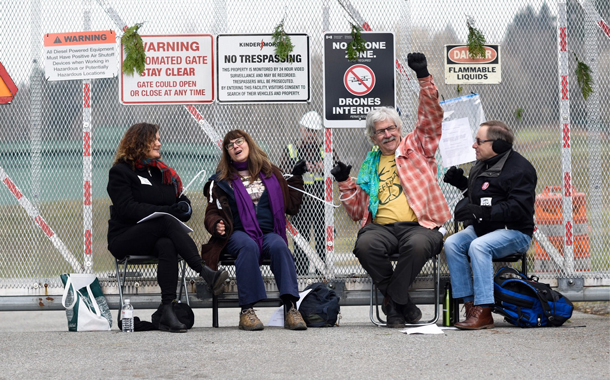
Protestors “chained” themselves to the gate at one entrance to the Burnaby Terminal site using large zip-ties. (Photo: Protect the Inlet)
CURWOOD: Mike, you got a hold of some internal government documents showing the public servants were directed to find a way to approve the Trans Mountain Pipeline of Kinder Morgan. Talk about what your investigation revealed.
DE SOUZA: A couple of things. First off, when the government was elected, they promised to fix Canada's environmental laws. There was this belief in the 2015 election that the Harper government had rigged Canada's environmental rules, had rigged the regulator so that it was biased in favor of industry. And so the government promised to fix the process to restart the review of the Kinder Morgan project. Right after they got elected, they started getting phone calls from Kinder Morgan. So, our reporting show that Kinder Morgan was lobbying not only politicians, but also high-ranking public servants who had risen to positions of significant power within the government during the Harper years and had gotten accustomed to doing things the way that Harper wanted them to be done. One of our first reports showed that after a phone call from Ian Anderson, the chief executive of Kinder Morgan Canada, the next day they started talking about speeding up the review and watering down the liberal government's promise. So, that resulted in the government speeding up its review. They did add some layers. They consulted some First Nations. But their minds were made up.
CURWOOD: As I understand Canadian history, the native groups never actually ceded their land to the British crown back in the day, and so it's sort of in a legal limbo. Your high courts have tried to wrestle with what rights do the First Nations have when it comes to this sort of thing.
DE SOUZA: One thing that's clear is the government is talking to First Nations right now; it has to do more to accommodate them. There are some First Nations that support this project that want to get an ownership stake in it, and, you know, maybe there's a solution for a better project that could be more environmentally responsible in the future. But right now that consensus isn't there, and there's certainly not consent from a lot of key First Nations that would be directly affected by this project.
CURWOOD: So, what's the political calculus of Justin Trudeau to tell the world that he is going to buy this pipeline so diluted bitumen can come onto the world market?
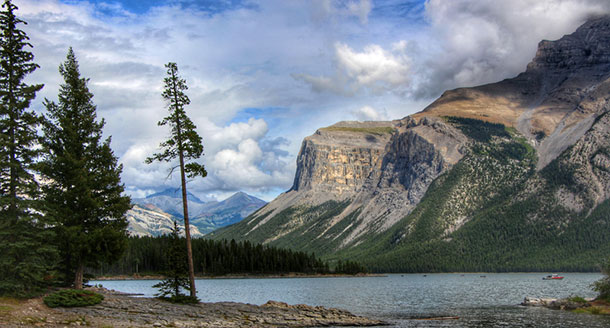
Potential oil spills from a Trans Mountain Pipeline threaten Alberta’s renowned wilderness, as pictured here in the Banff National Park. (Photo: Good Free Photos, public domain)
DE SOUZA: I mean, they're trying to look at the global picture. They hope to tell the rest of the world that we're still producing oil, we're still consuming oil around the world. And, you know, they're trying to make the argument that Canada can find a way to produce this oil in a more responsible way than Saudi Arabia or Venezuela would, and that it is under a framework where there is a price on carbon, there is an absolute cap. If this pipeline isn't built, both the Alberta government and the federal government – they say that there are the conservatives waiting in the wings. And they will be elected; they will form governments; and they will undo all of this if this pipeline isn't built. So, that’s, you know, in a nutshell what the political argument is: let us build this pipeline and then we can control the oil and gas industry's carbon pollution.
CURWOOD: Some might say this is rather cynical because if you export all that tar sands oil, it doesn't count. So, if China burns it, if Korea burns it… it's not on Canada's books. So, how are folks from environmental advocacy groups – the Green Party, the New Democratic Party, even the Liberal Party – how are they responding to this news?

Canadian Prime Minister Justin Trudeau. (Photo: Radio Television Malacañang, Wikimedia Commons, public domain 2015)
DE SOUZA: This week, there were environmental groups and other civil society groups organizing, essentially, the swarming of political offices, the offices of politicians across the country. They were surrounded by dozens of protesters and a hundred different federal politicians this week telling the government: we don't want this, we don't think this is the right path. So, that message is getting out there. The government is under intense pressure. You know, it’s not only the approval of the pipeline, but spending public money has been something – spending billions of dollars of public money, I think – it's something that is galvanizing the opposition against this. You have people who have knocked on doors and spent hours volunteering their time to campaign for the liberals in the last election that are very angry. People who say they elected, for example, the Environment and Climate Change Minister who represents in Ottawa, in Ontario, in central Canada, saying, I spent all this time campaigning for you and I feel betrayed.
CURWOOD: So, how does this dispute affect the upcoming election next year? It will be federal elections there in Canada. Trudeau could lose his job.
DE SOUZA: Absolutely, yeah, he could. His popularity has dwindled. The conservatives in some recent polls have been pulling ahead of the Trudeau liberals in Canada, but we are more than a year away from from elections. The prime minister himself has a certain personal popularity and way of connecting with people that perhaps helps them out, but if they want to be reelected, they're going to have to find a way to navigate this issue, particularly after deciding to spend public money on the project. They have to find a way to get First Nations more involved in this project, or they have to find an alternative.
CURWOOD: Mike De Souza is Managing Editor of The National Observer based in Ottawa, Canada. Mike, thanks so much for taking the time with us today.
DE SOUZA: Thanks for having me, Steve.
Related links:
- Mike De Souza for the National Observer: "Trudeau government 'sought to suppress the evidence' of pipeline 'gamesmanship,' say court documents"
- New York Times: “Canadian Government to Buy Trans Mountain Pipeline”
- History of the Trans Mountain Pipeline
[MUSIC: Chet Atkins, “Classical Gas” on Sweet Dreams, composed by Mason Williams, SME (on behalf of Columbia Nashville); Warner Chappell, Sony ATV Publishing, and 11 Music Rights Societies]
CURWOOD: Just ahead – the EPA says it’s too busy to broadly regulate toxic chemicals. That’s just ahead on Living on Earth – stay with us!
ANNOUNCER: Support for Living on Earth comes from the Gordon and Betty Moore Foundation and from a friend of Sailors for the Sea, working with boaters to restore ocean health.
[MUSIC: Chet Atkins, “Classical Gas” on Sweet Dreams, composed by Mason Williams, SME (on behalf of SME (on behalf of Columbia Nashville); Warner Chappell, Sony ATV Publishing, and 11 Music Rights]
EPA Dilutes Toxics Law
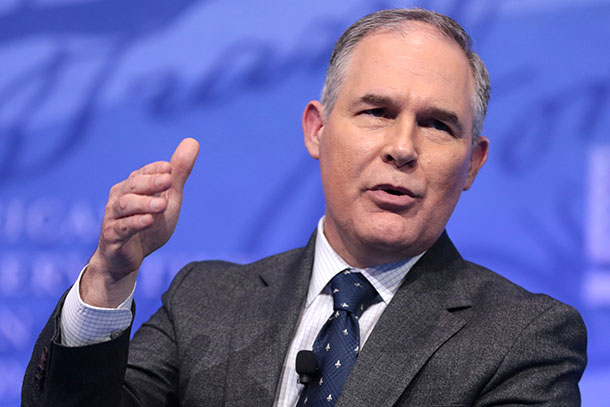
EPA Administrator Scott Pruitt has changed criteria for implementation of the Toxic Substance Control Act. (Photo: Gage Skidmore, Flickr CC BY-SA 2.0)
CURWOOD: It’s Living on Earth, I’m Steve Curwood.
In 2016, the decades-old Toxic Substances Control Act, also known as TSCA, received a long-awaited update after a bipartisan push. The legislative reboot gave the EPA a greater level of authority to regulate chemicals both new and existing, and the Obama Administration began reviewing 40,000 or more chemicals, with ten of immediate concern.
But there has been a change of direction under the EPA led by Scott Pruitt, and we turn now to Britt Erickson, who is Senior Editor at Chemical and Engineering News. Britt, how is the Trump Administration using their powers under TSCA today?
ERICKSON: Well, they're really not. It's almost business as usual. It's like the law had never been revised. The Trump administration is claiming they don't have enough time to implement the law; they don't have enough time to look at all of these uses; therefore, they have to just narrow down the amount of uses that they will evaluate. To their credit, they were given this huge task to do in a very short amount of time.
CURWOOD: So, wait a second. Something could be entirely toxic. The EPA says, hey, all right, we don't have enough time to check, so that's fine.
ERICKSON: It seems to be. They're looking at very narrow uses. So, if one particular use is fine, then they give it the green light. If, later down the road, someone says we want to use it for this use, well, then they will regulate it at that time.
CURWOOD: So, as I understand it, the Obama administration was going to look at many, many, many chemicals. How many chemicals is Scott Pruitt's EPA looking at now?
ERICKSON: Well, right now, they are required to look at 10. These are chemicals that are already on the market. So, those 10 chemicals, they need to evaluate by December 2019. If they find any risks with those 10 chemicals, then they have an additional two years to do something about those risks. So, we're looking at 2021, at the earliest, to see some sort of action on those 10 chemicals.
CURWOOD: And what are those 10 chemicals?
ERICKSON: Well, there's about seven of them are solvents, so things like trichloroethylene… ou may have heard of PERC used in dry cleaning, it’s tetrachloroethylene… there is methylene chloride in paint strippers.
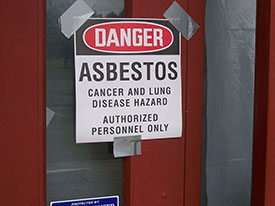
Asbestos is one of the 10 chemicals currently being evaluated by the Environmental Protection Agency. Because of the EPA’s newly announced methodology, their risk assessment will be excluding the impact from “legacy uses” of asbestos and certain other chemicals. (Photo: Ktorbeck, Wikimedia Commons, Public Domain)
CURWOOD: Isn't methylene chloride outright deadly?
ERICKSON: It absolutely is. It will turn into carbon monoxide, so it acts a lot like carbon monoxide, and it will kill you if you get too high levels of inhalation exposure to methylene chloride. In fact, it's actually happened to a few men who have used paint strippers in an enclosed space.
CURWOOD: How fair is it to say that the EPA is really ignoring how these chemicals are present in the air or the water in the ground?
ERICKSON: I'd say it is fair to say that. They're looking at current uses, and they're not looking at legacy uses for things like asbestos that's already in the environment, it's already in buildings. They're going to look the other way and not include that in the risk evaluation.
CURWOOD: Britt, help me. Some folks are saying that the EPA is actually going to ignore a huge amount of chemicals being emitted into the atmosphere and into the water. How accurate is that and what's the number, if you know?
ERICKSON: I would say that is a fair assessment. The Environmental Defense Fund, an environmental group, did an analysis and they found 68 million pounds of chemicals would still be released into the atmosphere, into the water, into the soil.
CURWOOD: So, what are the potential health impacts of the way that the Pruitt EPA is implementing the TSCA changes?
ERICKSON: Well, I think it's a shame for the subpopulations, the vulnerable subpopulations – the pregnant women, the children, the elderly, the immunocompromised. They're the ones who are really going to be hit by by the weakened rules.
CURWOOD: And to what extent are these chemicals carcinogenic and cause cancer?
ERICKSON: Most of the solvents are carcinogens, and they're extremely hard to get rid of once they're in the environment.
CURWOOD: So, you've been working in this arena for a number of years. What's your overall summary of how you think that the EPA is handling the risks from these toxic chemicals?
ERICKSON: Well, I think we were on the right track a few years ago when we were under the Obama administration. We had just passed that new TSCA, and EPA was looking comprehensively. They put out some proposals on how they would regulate these chemicals in commerce, and they said we will look at all of the uses. But now we've sort of turned the corner, and now we're looking only at very narrow uses, so I don't think we've improved very much.
CURWOOD: Any advice for people listening to us about how they could better protect themselves? Because it seems like the government is not going to protect us from some of these chemicals.
ERICKSON: That's right. I think a lot of these chemicals are things that your average consumer is probably not going to be exposed to. Methylene chloride in paint strippers – I mean, if you choose to use a paint stripper that's a chemical paint stripper, I think you need to wear the proper protection and you need to be aware of the hazards. Until they're banned from the market, people need to be aware that, yes, these products are dangerous and we do need to wear safety protection when we use them.
CURWOOD: For people who are concerned about these chemicals and and want to avoid an exposure, where can they get authoritative information about them, lower their risk?

Britt E. Erickson is Senior Editor at Chemical & Engineering News. (Photo: Chemical & Engineering News)
ERICKSON: Well, one place they can go is the Agency for Toxic Substances and Disease Registry. That is part of the Centers for Disease Control and Prevention in Atlanta, Georgia, and they create toxicity profiles for every chemical, and the consumers can look at that to determine whether a chemical is hazardous. Now, there's also a component to risk and that's exposure, so you have to also be exposed to a chemical to actually be harmed by it even if it is a dangerous chemical. So, if you take safety precautions, you won't be exposed. So, if you're using these methylene chloride paint strippers and you wear the proper safety gear, you'll be OK.
CURWOOD: Which of the 10 chemicals that the EPA is starting to look at is ambient in the environment, that is not something that somebody would deliberately use but just could be incidentally in the air or incidentally in the water?
ERICKSON: Well, what I can say is that the 1,4-Dioxane is an impurity in consumer products like cosmetics. So consumers could potentially be exposed to something like that. It's no longer used as an ingredient, but it's a byproduct in one of the processes that the manufacturers used to make surfactants that are used in these products. So, even though they're no longer adding it to your… and it won't show up on your ingredients list, it's an impurity and so I think things like that are problematic.
CURWOOD: Britt Erickson is Senior Editor at Chemical and Engineering News. Thanks for taking the time today, Britt.
ERICKSON: Thanks for having me.
Related links:
- The NYTimes: “The Chemical Industry Scores a Big Win at the EPA”
- Britt E. Erickson’s profile at Chemical & Engineering News
- Environmental Defense Fund: “Pruitt EPA Illegally and Dramatically Undermines Authority to Limit Dangerous Chemicals under Reformed Chemical Safety Law”
- EPA: Summary of the Toxic Substances Control Act
[MUSIC: Craven Joe and Sometimer, “China Doll”]
Beyond the Headlines
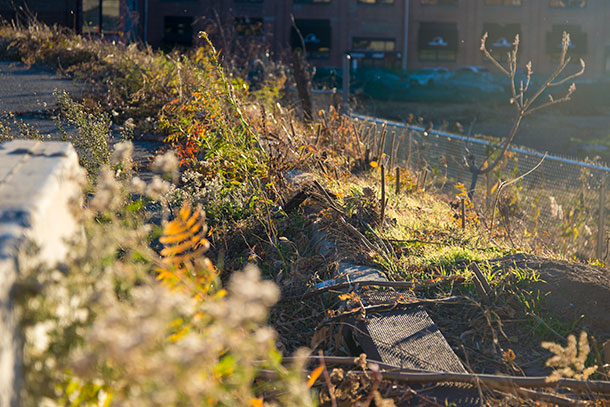
A Superfund Site in Edgewater, New Jersey, shows some signs of life, years after Quanta Resources Corporation shut down their oil processing facilities in 1981. (Photo: Anthony Albright [Quanta Resources Superfund Site], Wikimedia Commons, public domain)
CURWOOD: Let’s look behind the headlines now with Peter Dykstra. Peter’s with Environmental Health News, that’s EHN.org and DailyClimate.org down there in Atlanta, Georgia. It’s getting hot here in New England – what about you, Peter?
DYKSTRA: Well, summer’s definitely underway, but we haven’t hit the really hot stuff yet.
CURWOOD: So, what do you have for us today?
DYKSTRA: Let’s go back to my ancestral home, the state of New Jersey, specifically to Toms River, down on the Jersey shore. It was the site several years ago of a Pulitzer-Prize-winning book by environmental journalist, Dan Fagin – title of the book is also Toms River – about the toxic waste sites throughout the community that had poisoned drinking water wells and caused cancer clusters. But right now, at the biggest of those sites, the Ciba-Geigy corporation’s now closed-down plant where they made dyes and plastic resins, there’s an open-air classroom for high school students going on.
CURWOOD: Open-air classroom? Sounds a little risky to me in a Superfund site.
DYKSTRA: Well, they’re actually focusing on the non-polluted part of this very, very large factory site. They’re counting deer using remote cameras, and it’s a small gift back to the community from the current owners, the BASF company. But there’s still serious problems with the site and others in the area.
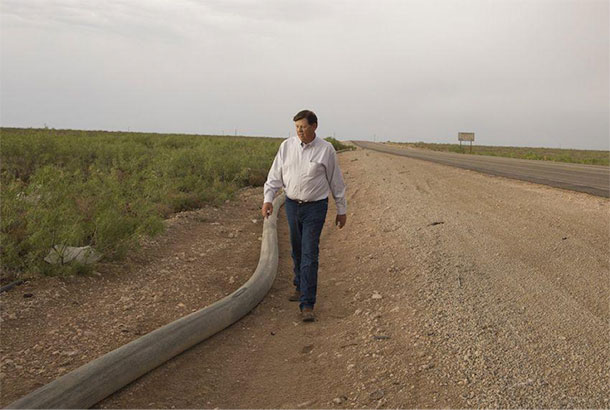
New Mexico State Land Commissioner Aubrey Dunn walks along Ranch Rd 652 at the Texas-New Mexico border on May 23, 2018, next to a water line that runs from Loving County, Texas, to Lea County, New Mexico. (Photo: Marjorie Kamys Cotera for The Texas Tribune)
CURWOOD: So, it’s gotten better, it sounds like, huh?
DYKSTRA: It’s gotten a little bit better. The ocean-discharge pipe that took waste from the plant all the way out into the Atlantic Ocean many miles away and dumped it there has long been shut down; the plant has long been shut down. They’ve removed a lot of the barrels from the site. But there’s still leaching of toxics into the Toms River, into the surrounding environment, and there are drinking water wells that will probably never be able to be used again.
CURWOOD: I guess that’s part of the lesson to students that some pollution is forever. Hey, what else do you have for us?
DYKSTRA: Let’s go to the state line of Texas and New Mexico. There’s a water war going on there. Water wars are nothing new. The two states have had them over the Pecos River and its water, over the Rio Grande. But this one is over an aquifer and use of the water for fracking. There’s been a huge fracking boom in the area. New Mexico regulates pumping out of the aquifer. Texas doesn’t. If you own land, you can take as much water out of the aquifer as you possibly want. And what the Texans are doing is selling some of that water back to New Mexico to feed fracking operations.
CURWOOD: Oh, I imagine the New Mexicans aren’t very happy. This is going to touch off a bit of a battle, I would say. And there’s that old saying out West: whiskey’s for drinking but the water’s for fighting.
DYKSTRA: That’s right, and this looks like a fight that’s going to go to court or going to go through the state’s legislatures for some time to come.
CURWOOD: So, open that door to the history vault, Peter, and tell me what you see inside.

In 1945 the explosive device known as “Trinity” was assembled for the first atomic bomb test. (Photo: U.S. Government, public domain)
DYKSTRA: June 17th, 1942. President Franklin Delano Roosevelt, in the middle of World War II, directs the US army to take charge of bomb making in the race for an atomic bomb against the Nazis. Two months later, the Manhattan Engineering District is formed by the Army Corps of Engineers, named after the apartment in Manhattan where some of the early planning went on. But of course, most of the work took place in that same state of New Mexico.
CURWOOD: That’s where they exploded the first atom bombs. Hey, it cost a lot of money back then. What’s happened to that now?
DYKSTRA: The money that it cost back then is nothing compared to what it costs now. Nuclear weapons were then put under the Atomic Energy Commission, then under the Department of Energy when it was formed in the seventies. Most folks don’t know this: the Department of Energy doesn’t deal that much with energy. Two thirds of its current budget are for the maintenance of nuclear weapons or the cleanup of past nuclear weapons messes.
CURWOOD: Oh my. Thanks, Peter! Peter Dykstra is with Environmental Health News, that’s EHN.org and DailyClimate.org. We’ll talk to you again real soon.
DYKSTRA: Ok Steve, thanks a lot. Talk to you soon.
CURWOOD: And there’s more on these stories at our website loe.org.
Related links:
- AP News: “New Jersey Superfund site now an open-air classroom”
- Texas Tribune: “New Mexico official says Texas landowners are ‘stealing’ millions of gallons of water and selling it back for fracking”
- Manhattan Project: “The Manhattan Engineer District”
[MUSIC: BIRDNOTE THEME]
BirdNote: Exquisite Thrush Song
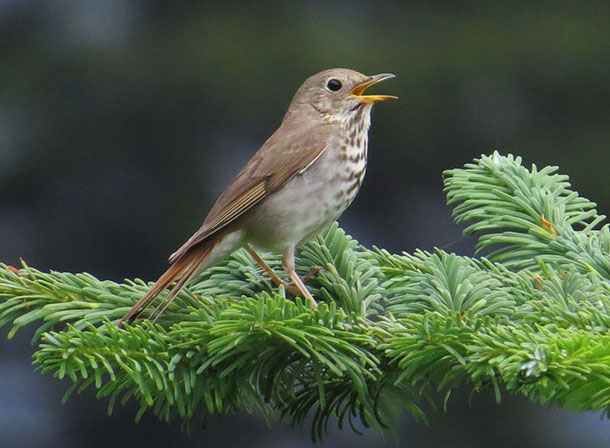
A Hermit Thrush coos on the branch of a coniferous tree. (Photo: Mike Hamilton ©)
CURWOOD: In nature all creatures are beautiful in their own ways, even if we don’t always understand or appreciate them. But there is one genus of birds that has some of the easiest songs for humans to love, as Michael Stein tells us in today’s Bird Note.
[Wood Thrush song]
STEIN: Some believe the song of the Wood Thrush to be the most beautiful bird song in North America.
[Wood Thrush song]
Others select the song of the Hermit Thrush.
[Hermit Thrush song]
Still others name the singing of the Swainson’s Thrush.
[Swainson’s Thrush]
STEIN: So how do thrushes create such fine music? The answer is that the birds have a double voice box. Bird song emanates from a complex structure, unique to birds, called the syrinx. Syrinx is also the Greek word for the musical instrument we call panpipes, which have multiple pipes. It’s a fitting name for this essential part of a bird’s vocal anatomy, because, like panpipes, birds have two separate pipes to sing with. A fine singer like a thrush can voice notes independently and simultaneously from each half of its syrinx, notes which blend brilliantly as ethereal, harmonious tones.
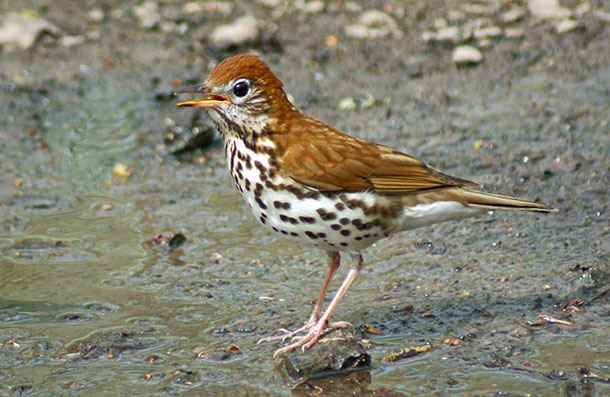
A Wood Thrush sings on the muddy banks of a small body of water. (Photo: Greg Miller ©)
[Hermit Thrush song]
Fortunately for us, the results are lovely and haunting.
[Wood Thrush Song]
I’m Michael Stein.
[Wood Thrush song]
CURWOOD: For photos of these songsters, wing your way to our website, loe.org.
And by the way, the wood thrush typically migrates north to the US in Early April from wintering grounds in tropical forests from southern Mexico to Colombia. Over the past several decades, the wood thrush population has declined by 60 percent or more, with the loss of habitat cited as the major culprit. But you can still hear them today, mostly after the leaves come out in the Eastern deciduous forests.
And for your listening pleasure, here’s a longer recording of a wood thrush that Lang Elliot made on a late April day in a deep ravine in the Smoky Mountains, as part of his series Music of Nature.
[Wood Thrush Song]
Related links:
- Listen on the BirdNote Website
- More on how songbirds produce their tunes
- Music of Nature: “Wood Thrush, Flautist of Nature” by Lang Elliott
CURWOOD: Coming up – wanderlust and the ice-age settlers of the Americas. That’s just ahead on Living on Earth – Keep Listening!
ANNOUNCER: Funding for Living on Earth comes from you our listeners and United Technologies, combining passion for science with engineering to create solutions designed for sustainability in aerospace, building industries, and food refrigeration. UTC companies such as Otis, Carrier, Pratt and Whitney, and UTC Aerospace systems are helping to move the world forward. You can learn more about United Technologies by tuning into the Race to Nine Billion podcast; listen at race to nine billion dot com. That’s race to nine billion dot com. This is PRI, Public Radio International.
[MUSIC: Art Blakey, “Let’s Take 16 Bars”]
Atlas of a Lost World: Travels in Ice Age America
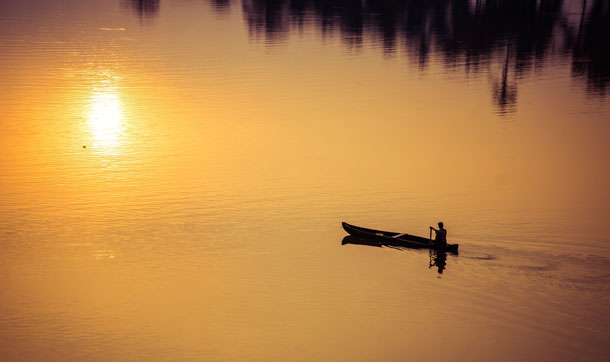
People likely traveled to the west coast of the Americas some of the way by boat – during the last Ice Age a massive ice sheet would have put a 2000 mile ice field in the way of their entry into the North American continent via the Bering land bridge. (Photo: mahfooz, Unsplash Creative Commons)
CURWOOD: It’s Living on Earth, I’m Steve Curwood. As the summer vacation season gets started, wanderlust is back at the fore. Some of us walk or bike, but most of us crowd onto planes, trains, ships, and automobiles to be transported to places where we can relax by the water or hike into the hillsides as we ‘get away from it all.’ And what may well be a genetic impulse to be in a new, or at least different place, may also explain why humans now occupy so much of the earth. Author Craig Childs has written “Atlas of a Lost World: Travels in Ice Age America.” Retracing the foot paths and waterways used by some of the first people to make it to the Americas, he channels the spirit of adventure they must have had.
Welcome to Living on Earth, Craig!
CHILDS: Thanks, Steve, for having me here.
CURWOOD: So, why write a book like this?
CHILDS: I think it's a blank space in a lot of people's knowledge about the Americas, what happened in the Ice Age. You might think of Clovis, you might think of mammoths, but it's a much more complicated story, and I want to take this blank space and fill it in and show this incredible moment where a side of the planet that had no people suddenly did have people. This is in a way a scientific creation story for this continent.
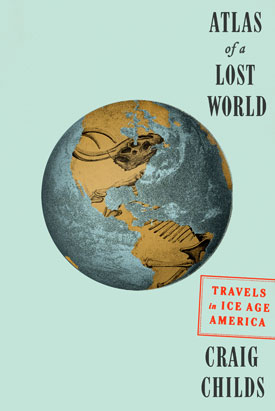
Author Craig Childs follows in the footsteps and along the paddle routes of the people who came to the west coast of the Americas thousands of years ago. (Photo: Courtesy of Craig Childs)
CURWOOD: What do you think are the most likely ways that people came here? You write extensively, of course, about the land bridge, but there were other ways as well.
CHILDS: Yeah, and the land bridge is probably the secondary route, and there were ways along the coast. Around 17,000 years ago, there was an ice mass about the size of an Antarctica sitting on half of North America. And it started retreating a little bit, which revealed a coastline so you could have gotten from the coast of the land bridge, the coast of Alaska, all the way down to Washington – by boat. On the Asian side – the Korean peninsula, Japan, Kamchatka – there was boat use going back 30,000 years to access islands you could have only gotten to from boats. So, these were probably small skin boats with wood frames, and they would have been coming down the west coast, and that's the most likely way that people in any large numbers would have gotten in. Because the land bridge, if you crossed it, it was a good place to be at the time – it was ice-free, it was a large landscape – you would run into a wall of ice on the other side, and you would have had to cross 2,000 miles of polar wasteland before touching ground again. So, I think the coast is appearing more and more as the likely way that humans got into North America.
CURWOOD: Talk to me about your quest to see what it would have been like for early people to travel along the coast via boat with a little bit of a retreat of the ice. Why did you travel the same kinds of routes that the early people in America might have undertaken?
CHILDS: I tried in as many places as possible in this book to travel in a way they would have traveled – not necessarily with skins and loincloths and spears because I think I would have died out there if I had done that [LAUGHS] – but I wanted to travel in a social way. A migration doesn't exist without kids, and so we had a group of kids going down the coast of south central Alaska, and kids ranged in age from four to 12. And so it was just the group of families. My kids were there as well, and it was interesting to navigate, to move from island to island, and send the adults ahead to check for bear presence, and having kids in big bear country is just an intense experience in general. I mean, I've traveled in Alaska quite a bit, and it's a place where it's a little wilder. It's a little bit more edgy, and it gives me a sense of maybe the ice age was a hundred times wilder. The animals are so much larger and the predators are numerous and huge, so what would it have been like to have had kids there? I travel with children frequently to remote places, and I think that this is so important because there's there's the adventure aspect going out just yourself with a couple other people who are just wild and you can just die out there and it doesn't matter. But when you're with kids, it's a whole different story. You're paying attention to things on a very different level. It's no longer about you. It is now about the adventure of your children.
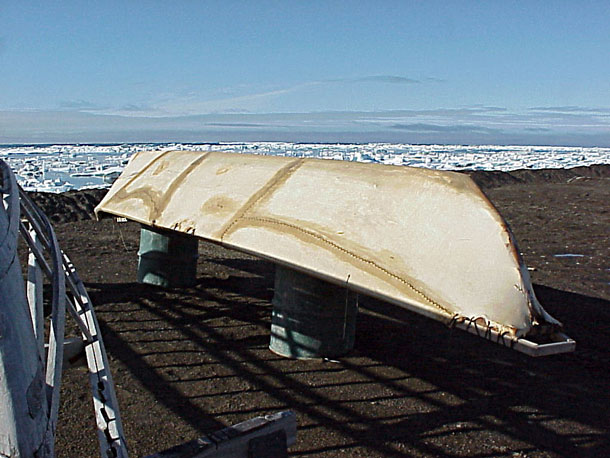
An umiaq, a type of skin-covered boat similar to what people may have used to travel along the coast of the Bering Land Bridge from Asia into North America. (Photo: Floyd Davidson, Wikimedia Commons CC BY 2.0)
CURWOOD: So, as you travel down the southeast coast of Alaska, what did you eat, and what do you think that people several thousand years ago would have eaten making that trip?
CHILDS: Well, with kids we had juice boxes. [LAUGHS] We had the 21st-century child panorama, but we also fished, we gathered clams, probably half of the food we ate was subsistence – and I think that in the ice age they were doing the same thing. They were eating whatever resource was available. There's evidence along the coast of people eating seaweed, seals, shellfish, mastodon. And there's plenty of evidence of plant use: of seeds, roots, grasses, so they weren't specialists. They certainly weren't just eating mammoths. The mammoth kills are just the most obvious because they're the largest remains, but if you get a good site with a fire and maybe the remains of a hut where you can see where people ate, you see that they were eating off the land just like you and I would if we were familiar with the place.
CURWOOD: So, science can easily document that there are humans in the Americas by, what, some 15,000 years ago, but there is some evidence that goes back much further. In fact, in your book, you hint at 130,000 years. What are these faint glimpses that we have?
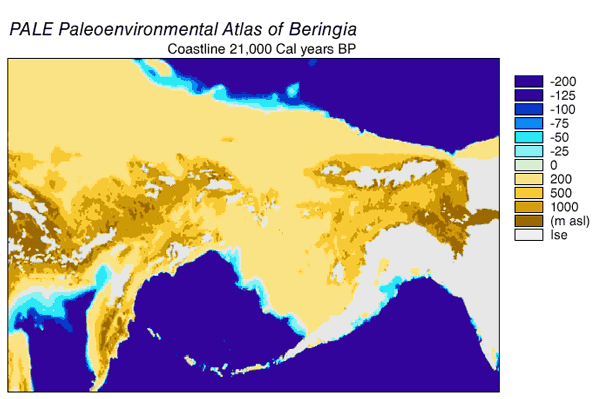
The shrinking of the Bering Land Bridge from 21,000 years before present to modern times. (Image: Courtesy of NOAA)
CHILDS: Yeah, the dates keep going back. The more closely we look, the more we see, and this 130,000-year-old find is pretty recent. It came out of San Diego and it is remains of a mastodon that looks like the bones have been shattered with a stone lifted and brought down on them and then there are rock cobbles around the bones that shouldn't naturally be there. So, it looks like an organized site that somebody took a big bone from a mastodon and smashed it and maybe got marrow out of it and left tools there. You could argue that they were trampled, but the bones looked like they were worked by humans. Since it's only one find, it's heavily debated whether this is actually human or hominid or not, but there is also evidence of bone breakage of these big animals – mastodons, bison, giant ice age bison – going back 40,000 years, so I think that we're going to keep seeing older and older dates. But there were definitely people here 15,000 years ago, likely people here 20,000 years ago. If you think about how humans migrate and the way we just go off the edge of the Earth that we look for horizon after horizon, I think it is inevitable that humans were here much earlier than we think.
CURWOOD: Craig, we need a little lesson in paleo history and ice ages. Talk to us about the periods before the massive settlements here in America and, in particular, something known as the Younger Dryas and how that might have affected things.
CHILDS: Well, ice ages are really unstable times. As we look at climate change now, we're struck by incremental changes in temperature and sea level rise because they do directly affect us and the rest of the world. But ice ages are up and down. The Younger Dryas was a cold period that struck around 12,000 years ago, and the ice age had been warming – glaciers are retreating, rivers are huge, lakes are everywhere – and then suddenly, maybe even within 10 years, the northern hemisphere plunged back into full ice age conditions. So, the glaciers started growing again; permafrost started spreading everywhere. So, it was a rapid and radical change.
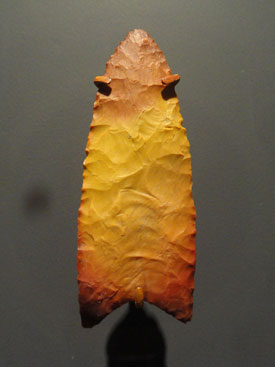
A Clovis point, c. 11,500-9000 B.C., displayed in the Natural History Museum of Utah in Salt Lake City, Utah. (Photo: Daderot, Wikimedia Commons CC 1.0)
CURWOOD: And how did that affect migration do you think?
CHILDS: I think it increased migration. It was like a pool cue hitting balls and just sending them every direction – that this was the sudden change, people had to adapt, they had to find new niches, and so it kind of divided everybody up. Whereas before the Younger Dryas, it was more of a uniform continent where they were using the same kind of weapon in Maine as they were in California. After the Younger Dryas, there were many different kinds of weapons. It was the Babylon moment where languages divided, technologies divided, and we ended up with the foundation of the continent we see today.
CURWOOD: In your book you write about the presence of a genetic marker in some people, called D4, that you say seems to be correlated with adventure and restlessness. What do we know about its presence in the first Americans?
CHILDS: Well, D4, it indicates a dopamine receptor, and people who tend to be less cautious, more risk takers, long travelers, they tend to have more D4… and I think every species has a version of this. Every species needs individuals to go out beyond the horizon and find another niche. It's how we survive, that if something goes wrong at least we know there's a backup somewhere that somebody found. And if you look at the presence of D4 in native genomes from from the Arctic to the tip of South America, you'll see that D4 increases as you go south. And to me that makes sense, that people coming in across the land bridge and down the coast would have… those with less D4 would have settled earlier. They would have gone into North America and said, this looks great. They would have landed in California and that's it.
Other people would have kept pushing and ended up in Central America. Then if you had even more, you would have kept going south into South America, which was the farthest place humans could have reached on Earth, the farthest habitable landscape. So, there is evidence that there is a genetic drive to go farther, and some people do it, and they carry those genes and they carry them all the way to the end of the Earth. I know people who have… who must have just D4… just chock full, because they don't come back. They just keep traveling and I find them somewhere else out in the world and I think, you are the real explorer. I like to come home.
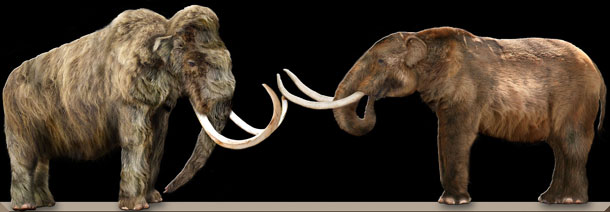
Although natural climate change played a role in the demise of the woolly mammoth (left) and the American mastodon (right), humans appear to have contributed substantially to their extinction towards the end of the last ice age. (Photo: Dantheman9758, Wikimedia Commons CC BY-SA 3.0)
CURWOOD: Stone bifaces – the tools, the weapons, of the paleo human – feature prominently in your book. You keep returning to them. These are the artifacts you described for your readers; you turn them over reverently in your hand. Why do these worked stone objects hold so much power for us do you think?
CHILDS: When you hold one of them in your hand and you're holding up a rock that somebody fashioned 15,000 years ago, you're seeing the actual hammer blows of their strikes. The actual object takes you back to that moment: you can hear the sound of stone on stone, of their work. And I went down into a trench, at a dig in Texas where they're coming across human artifacts 15,500 ago, and I picked one up from the very bottom of the dig. It was still sharp enough that you could have cut flesh with it, and you're holding this thing that somebody else touched. The last person to touch it was that person during the Ice Age where they were mammoths around this flint napper, and so you're transported back. You feel time in a very different way. It's making contact with a time that we don't have. I mean, most of our lives we're touching things that were just made a month ago or a year ago where everything is getting newer and newer, and I want to remember what it was like. I want us to have a context of how long humans have been doing this and touching this object is a way of making direct contact with those people.
CURWOOD: Holding these objects, what kind of feelings come up from yourself and for the people that might have made them?
CHILDS: Well, it's an interesting feeling because in one sense I feel like going, yeah, humans, I know you, you're like me, we're the adventurous species, we’re the pioneers, we will do anything. And then there is this kind of dread of, oh my God, we're humans, we're these pioneers, we're making weapons and this is what we do. We spread as far as we can. So, I have this very mixed relationship with our species that's a bigger relationship than just being here now. It's a relationship with us going back tens of thousands of years, and in one sense I feel like a cheerleader for the species that I'm so proud and impressed with what we do but, in the other sense, I'm horrified by what we do because I think, is there no end to this? Are we just taking down every animal we can? Are we just building weapons upon weapons? So, I have a very mixed reaction when I meet these ancient people through their artifacts.
CURWOOD: Craig, before you go, what kind of message do you see in the way people have adapted to climatic change in the past for our current predicament as we face rapid climate disruption?
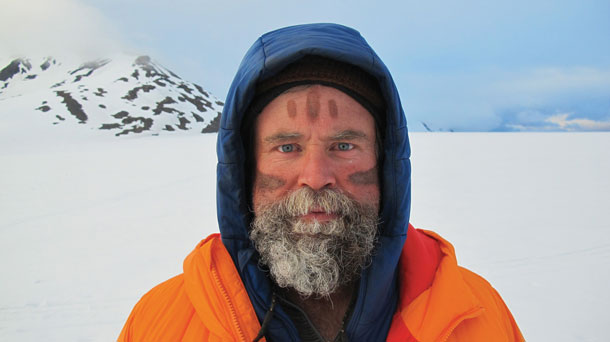
Craig Childs is the author of Atlas of a Lost World and seven other books. (Photo: Sarah Gilman ©)
CHILDS: Well, people adapted. They figured out how to get around the collapse of the Ice Age and something that I saw in their adaptation was that they, at the last moment when climate was really erupting around 13,000 years ago and you were having massive floods and sea level rise, people started making giant weapons and started killing the largest animals around and that – the world was coming apart, so they made themselves huge. And in doing so, they killed off the last remaining large megafauna. And I'm looking at us now thinking, oh, we're doing the same thing.
We're making massive weapons. We're making ourselves huge. And I'm not convinced that we have changed that much since 13,000 years ago. I think we are very much still the same people, but I am hoping that we've got a better grasp on the world we live in so that maybe we don't have to make ourselves so huge, that in the Ice Age they eventually stopped making giant weapons. Their weapons became smaller and smaller to adapt to changing climate and changing animals. I think that we could do the same, but maybe we can get a jump on it. Maybe we can change before the change happens.
CURWOOD: Craig Childs is the author of “Atlas of a Lost World: Travels in Ice Age America.” Craig, thanks so much for taking the time with us today.
CHILDS: Thank you for having me, Steve.
Related links:
- Atlas of a Lost World: Travels in Ice Age America
- About Author Craig Childs
[MUSIC: “Farewell To A-C”]
Audio Postcard: A Fisherman Rigging Bait on Nantucket

Richie explains how he rigs bait for his employer. (Photo: Jenni Doering)
CURWOOD: Not so long ago our crew headed to Nantucket Island where there is a long history of providing safe harbor to seafarers and whalers. Today luxury cruising and fishing boats dock there, and among the polished yachts, we found a scrappy fisherman with a weather-beaten face who was nimbly prepping bait.
RICHIE: My name’s Richie, and I’m just out here rigging some baits to go fishing. Ballyhoos, and we’re gonna rig em’ up and hopefully catch some fish. I’m a kind of a late bloomer in this game, but – I started at 40 and I am 58, so 18 years I’ve been fishing, you know? And I kind of like it.
I thought I knew what I was doing until I actually started doing it and you’ve got to learn a lot. You know, what kind of line, all the knots, how to rig baits, you know, different areas, there’s different ways of fishing.
You know, it’s not just like, get a six pack and buy a can of worms. It ain’t that easy. But, you know, it’s like anything else: you learn as you go. But we don’t get to do this without a sponsor, meaning the owner of the boat. We just work here.

Matt Hoisch records as Richie rigs bait, while a crewmember looks on. (Photo: Jenni Doering)
We’re milking him out. Gotta get all of the guts and the poop and everything out of him. And then you squeeze his back. And then when I rig him, I’ll put a little lead under his chin. Then you come up through the bottom here, through his beak. It’s like sewing. Gonna trim this off nice and neat. One more time.
And that’s it. That’s a rigged bait. And then the hook is on the smaller poles and you put the hook through here, and he just swims along. Pretty cool, huh? And then they go in the cooler. Line them up like little soldiers in here.
We’ve got other baits, but these are – we’re going to rig them a little bit differently. These are for our teasers. You know, and then you just line them up in here all nice and neat, and you’re ready to fish.
CURWOOD: Matt Hoisch produced this audio postcard.
Related link:
Another Living on Earth postcard from the Nantucket wharf
CURWOOD: We leave you this week deep in a dark conifer forest in the company of wolves.
[WOLF SOUND]
CURWOOD: A lone wolf calls out among the pines, and a large pack of timber wolves and their pups chime in. Timber wolves are large, a subspecies of the gray wolf, and live in packs of up to 20 members.
[WOLF SOUNDS]
CURWOOD: These wolves were recorded by Brian Wright for the International Wolf Center CD “Timber Wolf in the Tall Pines.”
[WOLF SOUNDS]
[MUSIC: Kavita Shah, “Little Green” on Visions, composed by Joni Mitchell, Inner Circle Music]
CURWOOD: Living on Earth is produced by the World Media Foundation.
Our crew includes Naomi Arenberg, Bobby Bascomb, Thurston Briscoe, Savannah Christiansen, Jenni Doering, Jaime Kaiser, Hannah Loss, Don Lyman, Aynsley O’Neill, Adelaide Chen, and Jolanda Omari.
And after a decade of finding great stories and making sure we tell them with style and the proper use of the English language, Helen Palmer is heading into retirement. Her tireless devotion will be missed. Thank you, Helen!
Tom Tiger engineered our show, with help from John Jessoe and Jake Rego. Alison Lirish Dean composed our themes. You can hear us anytime at L-O-E dot org – and like us, please, on our Facebook page – PRI’s Living on Earth. And we tweet from @livingonearth.
I’m Steve Curwood. Thanks for listening!
ANNOUNCER1: Funding for Living on Earth comes from you, our listeners and from the University of Massachusetts, Boston in association with its School for the Environment, developing the next generation of environmental leaders. And from the Grantham Foundation for the Protection of the Environment. Supporting strategic communications and collaboration in solving the world’s most pressing environmental problems. Support also comes from the Energy Foundation, serving the public interest by helping to build a strong clean energy economy. And from Solar City, America’s solar power provider. Solar City is dedicated to revolutionizing the way energy is delivered by giving customers a renewable alternative to fossil fuels. Information at 888-997-1703, that’s 888-997-1703.
ANNOUNCER 2: PRI, Public Radio International.
Living on Earth wants to hear from you!
Living on Earth
62 Calef Highway, Suite 212
Lee, NH 03861
Telephone: 617-287-4121
E-mail: comments@loe.org
Newsletter [Click here]
Donate to Living on Earth!
Living on Earth is an independent media program and relies entirely on contributions from listeners and institutions supporting public service. Please donate now to preserve an independent environmental voice.
NewsletterLiving on Earth offers a weekly delivery of the show's rundown to your mailbox. Sign up for our newsletter today!
 Sailors For The Sea: Be the change you want to sea.
Sailors For The Sea: Be the change you want to sea.
 The Grantham Foundation for the Protection of the Environment: Committed to protecting and improving the health of the global environment.
The Grantham Foundation for the Protection of the Environment: Committed to protecting and improving the health of the global environment.
 Contribute to Living on Earth and receive, as our gift to you, an archival print of one of Mark Seth Lender's extraordinary wildlife photographs. Follow the link to see Mark's current collection of photographs.
Contribute to Living on Earth and receive, as our gift to you, an archival print of one of Mark Seth Lender's extraordinary wildlife photographs. Follow the link to see Mark's current collection of photographs.
 Buy a signed copy of Mark Seth Lender's book Smeagull the Seagull & support Living on Earth
Buy a signed copy of Mark Seth Lender's book Smeagull the Seagull & support Living on Earth

